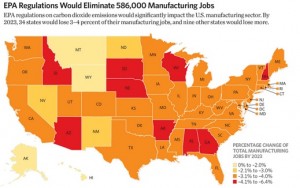Wisconsin is poised to lose more than 20,000 manufacturing jobs by 2023 because of the Obama administration’s proposed regulations on cutting carbon emissions that critics say will have minimal environmental effects.
The 4.19 percent reduction in manufacturing jobs puts Wisconsin at the fifth highest drop in the country, according to a study released this week by the Heritage Foundation, a conservative-leaning think tank based in Washington, D.C.
The only other states that would experience a higher percentage of job losses are New Hampshire, Idaho, South Dakota and Nebraska.
Nationwide, the proposed U.S. Environmental Protection Agency guidelines championed by President Barack Obama would eliminate more than 1 million jobs, with close to half coming from the manufacturing industry, the report says.
The suggested rules would also decrease the gross domestic product by $2.5 trillion over 15 years, according to the study.
“This is going to have a tremendously devastating effect on the economy, and for no environmental benefits,” Heritage Foundation fellow Nick Loris, who co-authored the report, told Wisconsin Reporter.
The Clean Power Plan, proposed by the EPA last year as part of Obama’s centerpiece strategy on climate change, calls for a 30 percent cut in carbon dioxide and other greenhouse gas emissions by 2030. The proposal establishes different target emission rates for each state due to regional variations in general mix and electricity consumption.
But some have argued the restrictions will have little, if any, influence on global temperatures or climate.
Eric Bott, director of environmental and energy policy for Wisconsin Manufacturers and Commerce, said the manufacturing sector is only responsible for roughly 4 percent of global manmade greenhouse gases. A 30 percent reduction would equate to approximately 555 million metric tons in 2030 or just 1.3 percent of projected emissions in that year.
“These regulations aren’t about reducing hazardous, toxic pollutants,” Loris said. “It’s all about climate change emissions and the reality is, whether you believe climate change is a catastrophic problem or not, these regulations won’t do anything to mitigate global temperatures, and the cost will be significant.”
Wisconsin and its leading manufacturing industries would be among those hardest hit.
More than 458,000 Wisconsin workers have manufacturing jobs, which amounts to 16 percent of the state’s total employment, or twice the national average, according to data compiled by Todd Stuart, executive director of the Wisconsin Industrial Energy Group.
But 20,421 of those jobs would be eliminated by 2023 due to the Clean Power Plan, according to the Heritage Foundation study.
Wisconsin Public Service Commissioner Ellen Nowak estimates the added costs to residents and businesses will be in the range of $3 billion to $13 billion. That total for the entire country would be $284 billion in 2020, according to a November study by Energy Ventures Analysis.
The same report also states the average Wisconsin household would see an annual utility bill increase of $485 by 2020, a 28 percent hike. The average national increase would be $680 a year.
“These regulations, in essence, act like a huge tax on, not just American families and businesses, but obviously the energy-intensive ones,” Loris told Wisconsin Reporter.
Some manufacturing companies in the state have seven-figure energy bills every month and would have a tough time surviving a large increase, Bott said.
Loris believes some businesses would be able to “swallow the higher costs,” but that likely would lead to less investments in new equipment and infrastructure, layoffs and higher prices for consumers.
“A big part of the problem with these regulations is that families aren’t just hit when their energy bill comes in the mail,” Loris said. “They are hit again and again through all the goods and services we pay for because energy is in just about everything we make and create. It will have a tremendous ripple effect through the economy.”
Bott also has concerns over the portion of the Clean Power Plan that allows states to have different emission rate guidelines. He says that provision is punishing states that have already been working on reducing greenhouse gas emissions by giving them stricter requirements.
That could force some firms to move out of Wisconsin, Bott said.
“There’s a real inequity in terms of compliance costs created between states and that opens the doorway for large companies that operate in local states to ship production in order to avoid those huge cost increases,” Bott told Wisconsin Reporter.
The EPA has delayed finalizing the Clean Power Plan until this summer, a move some say was made to stave off legal challenges.
Wisconsin Gov. Scott Walker said in his State of the State Address in January he plans to work with Attorney General Brad Schimel to prepare a lawsuit against the federal government over the carbon emission regulations.
Bott also indicated it’s likely Wisconsin Manufacturers and Commerce will engage in litigation on the proposed rules.


